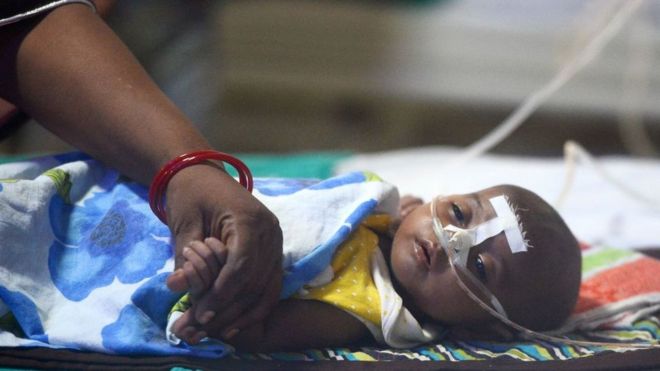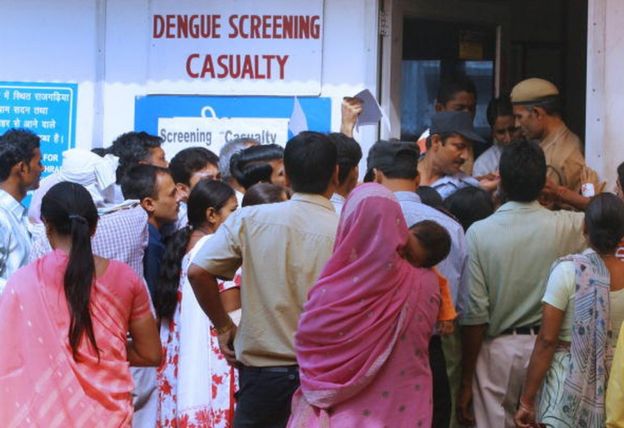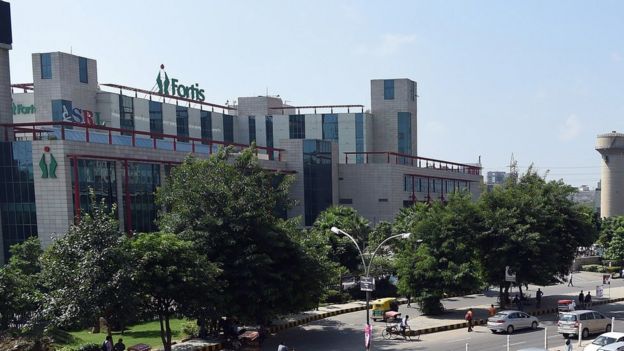 |
| India presently spends a little over 1% of its GDP on public healthcare |
On the face of it, it is difficult to not warm to India's newly announced flagship health insurance scheme, designed as a safety net for millions of people who struggle to afford quality medical care.
India has an abysmal record in public health. It presently spends a little over 1% of GDP on public healthcare, one of the lowest levels in the world.
Poor health and steep costs alone are responsible for pushing between three and fiver percent of the population below the poverty line. Rural households source more than a quarter of their health expenses by borrowing or selling assets.
India's disease burden - borne mainly by the poor - is higher than in many emerging economies. Quality state-run hospitals are few and far between, primary care facilities are poor and private clinics are prohibitively expensive.
The insurance scheme announced in the federal budget - dubbed "Modicare" after Prime Minister Narendra Modi by his supporters - would cover more than 500 million Indians and provide 500,000 rupees ($7,825; £5,520) in medical coverage for each family annually.
The government estimates that the premium for insuring each family would come to around $17 (£11.93), and the scheme will cost $1.7bn in federal and state funds. Finance Minister Arun Jaitley has said it will be the "world's largest government-funded healthcare programme".
The scheme seeks to cover the poorest of Indians - some 29% of Indians live below the poverty line - and the lower middle class, the two most vulnerable groups. They hold irregular jobs or are jobless, have few assets and are saddled with high-interest informal debt as well as having to pay for their own healthcare.
So to provide such people with decent publicly-funded medical treatment is indisputably a step in the right direction.
 |
| India's public health system is overcrowded and underfunded |
"The programme is bold and recklessly ambitious", K Sujatha Rao, former health secretary and author of a magisterial book on India's health system, told me. "Our health sector has been ignored for a long time. But the big challenge is implementation."
That is, indeed, the biggest worry.
Federal healthcare schemes and similar publicly-funded medical insurance schemes - more than a dozen Indian states have adopted such schemes since 2007 providing secondary and tertiary care hospitalisation, albeit with much lower coverage - don't have a very inspiring record.
Nine of 13 studies assessing such schemes reported no reduction in out-of-pocket expenses by people covered by insurance. An assessment of a publicly funded health insurance scheme for the poor launched in 2008 covering some 130 million people found that it had not "provided any significant financial protection" for poor households.
Illegal payments
One such study is of a publicly financed health insurance scheme for the poor in the central state of Chhattisgarh. It found that 95% of the insured who used private hospitals and 66% of the insured who went to government hospitals were stillspending on treatment from their pockets.
In state hospitals, where treatment is supposed to be largely free, patients ended up buying consumables and medicines from private pharmacies because the hospitals simply didn't have enough supplies. Also, illegal payments had to be sometimes to doctors and nurses.
Private hospitals, according to study author Sulakshana Nandi simply told patients that they could not afford to provide treatment at the government-mandated rates under the scheme and asked them to pay the difference.
 |
| India has a thriving private hospital industry, mainly catering to the rich |
India's private healthcare system is largely unregulated, opaque and often unscrupulous. It can also overcharge with impunity, leading to increasing conflict with patients.
Many believe that private facilities are actively hostile towards the poor and do not allocate enough of the mandated cheap beds for them.
"The good thing is that health is now becoming a political imperative, but we are still sleepwalking into delivery architectures without serious regulatory capacity," says Pratap Bhanu Mehta, chief of the India's Ashoka University.
Game changer?
Furthermore, quality private healthcare is mainly available in big cities and towns, and it is difficult to see how some of India's poorest of the poor living in remote areas and insured under the scheme will be able to reach any of these facilities.
What many miss is that the poor are actually impoverished by outpatient costs rather than hospitalisation expenses. Diagnostic tests, doctor follow-ups, basic medicines (statins for heart disease or diabetes control and psychotropic drugs for mental health, for example) and post-operative home care are expensive.
So just covering hospitalisation expenses may not help - one southern state, for example, provides free drugs to poor patients until a year after a surgical procedure, something that the federal scheme can adopt.
If implemented properly, the massive healthcare programme will be a game-changer for the poor. But, going by past experience and India's spotty record in public deliveries and weak regulation, the government will have to put in a lot of effort make it work.
Source: BBCNews

No comments:
Post a Comment
Add a Comment...